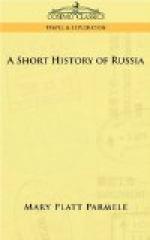Slav society was everywhere founded upon the patriarchal principle. The father was absolute head of the family, his authority passing undiminished upon his death to the oldest surviving member. This was the social unit.
The Commune, or Mir, was only the expansion of the family, and was subject to the authority of a council, composed of the elders of the several families, called the vetche. The village lands were held in common by this association. The territory was the common property of the whole. No hay could be cut nor fish caught without permission from the vetche. Then all shared alike the benefit of the enterprise.
The communes nearest together formed a still larger group called a Volost; that is, a canton or parish, which was governed by a council composed of the elders of the communes, one of whom was recognized as the chief. Beyond this the idea of combination or unity did not extend. Such was the primitive form of society which was common to all the Slavonic branches. It was communistic, patriarchal, and just to the individual. They had no conception of tribal unity, nor of a sovereignty which should include the whole. If the Slav ever came under the despotism of a strong personal government, the idea must come from some external source; it must be imposed, not grow; for it was not indigenous in the character of the people. It would be perfectly natural for them to submit to it if it came, for they were a passive people, but they were incapable of creating it.
CHAPTER III
RURIK AND HIS DESCENDANTS
The Russian Slavs were an agricultural, not a warlike, people. They fought bravely, but naked to the waist, and with no idea of military organization, so were of course no match for the Turks, well skilled in the arts of war, nor for the armed bands of Scandinavian merchants, who made their territory a highway by which to reach the Greek provinces. All the Slav asked was to be permitted to gather his harvests, and dwell in his wooden towns and villages in peace. But this he could not do. Not only was he under tribute to the Khazarui (a powerful tribe of mingled Finnish and Turkish blood), and harried by the Turks, in the South; overrun by the Finns and Lithuanians in the North; but in his imperfect political condition he was broken up into minute divisions, canton incessantly at war with canton, and there could be no peace. The roving bands of Scandinavian traders and freebooters were alternately his persecutors and protectors. After burning his villages for some fancied offense, and appropriating his cattle and corn, they would sell their service for the protection of Kief, Novgorod, and Pskof as freely as they did the same thing to Constantinople and the Greek cities. In other words, these brilliant, masterful intruders were Northmen, and can undoubtedly be identified with those roving sea-kings who terrorized Western Europe for a long and dreary period.




